That blessed freedom from gravity, heat, cares and constraints conferred by the summer’s first dive into the aquamarine purity of a pool is celebrated by Lorraine Shemesh in the refreshing solo exhibition, “Inside Out,” at the Gerald Peters Gallery on the Upper East Side.
Summer looks irresistible in the vertiginous Surrender, one of seven large oil on canvas paintings that display this accomplished figurative artist at her most virtuosic, stirring a hyperactive maze of light effects in views of a pair of outstretched hands lazily drifting outside a big indigo inner tube, as seen from the bottom of the deep end.
.
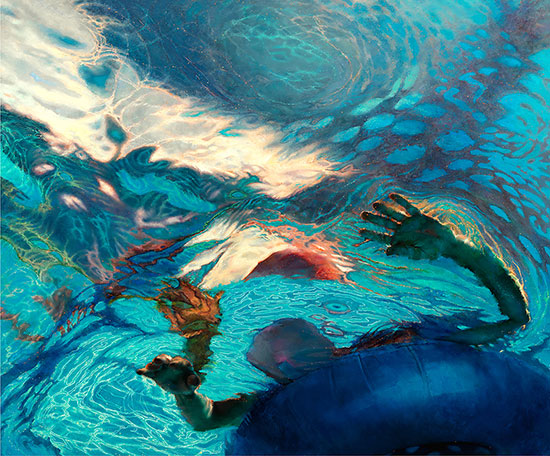
"Surrender" by Lorraine Shemesh, 2015. Oil on canvas, 58 x 70 inches.
.
The balance of abstraction and figuration in the show is almost stroke for stroke, as reflection and refraction perform their distorting act with the waterline as mediating edge. Just in terms of transcribing the visual information alone, the swimmers are heady demonstrations of technical ambition.
It is enough of a challenge for even the most adept and dedicated artist at life drawing sessions to hold together the proportions and shadows in a double figure pose such as Bridge, the most compelling composition in the show. Bridge gains impact and effectiveness from the absence of all the restless deformations of disturbed water, rendering it the most secure composition in the exhibition.
.

"Bridge" by Lorraine Shemesh, 2011. Oil on canvas, 47 1/2 x 79 inches.
.
The young boy and girl complete an underwater ellipse, holding each other’s ankles (the boy’s feet and her hands are just barely cropped), circling in a water ballet just below the surface. The architecture of the large painting is assiduously worked out in the deft graphite wash on mylar drawing, also in the show, that crochets each lacy aperture of sunlight and shade across his back, her thigh and white bathing suit.
.

"Bridge" by Lorraine Shemesh, 2011. Graphite wash on mylar, 22 x 37 inches.
.
That web of light, like a loose craquelure across the curvature of their limbs, is one of the most active chromatic passages in the painting, with a flickering spectrum of golds and tangerine strokes infiltrating the blue of the pool and sky. Discretely hung in a different part of the gallery, a second drawing, the most “abstract” moment in the show, is a loose pencil version of the ghostly figures that just hints at the final work.
Shemesh takes the securely realist figures in Bridge and submits them to a process of de-formation (“opened, broken and exploded”) that retains its thread to realism through the optics of reflection and refraction (the bending of form, multiplied and interrupted a hundredfold by the wave action of the surface). The call and response between form and its transformation lends a double life to most of the paintings.
The artist attributes her plunge into the freedom of abstraction to encounters with the paintings of Jackson Pollock, and the skeins of vigorously cast paint that dance across the surface of Crescent or Totem, two of the soaring vertical works, have a certain family resemblance to Pollock, but the fidelity to perception moors these works securely to the buoy of realism.
.
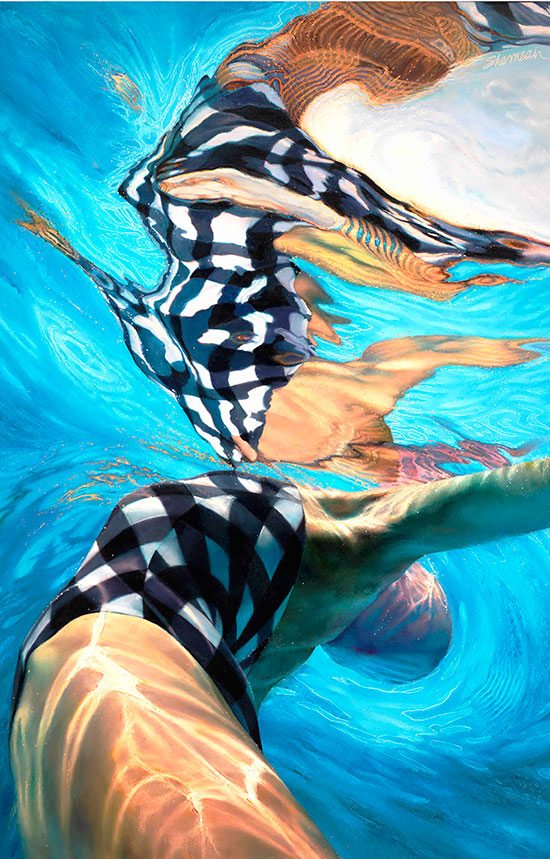
"Crescent" by Lorraine Shemesh, 2013. Oil on canvas, 75 x 48 3/4 inches.
.
The Ovidean shape-shifting is not just a matter of optics and painterly bravura, but a philosophical position, just as it is in Ovid, Heraclitus, even Heisenberg and so many poets of mutability from Shelley through Wallace Stevens. As the artist points out in an eloquent preface to the handsome catalogue accompanying the show: “Pattern, whether it is planned or improvised, is memorable because it has the capacity to transform things. The process of developing various repeated patterns in order to create movement, rhythm, and harmony presents the possibility of a visual metamorphosis in the work at hand. I was drawn to water as a subject because of its myriad of patterns in constant flux.”
.
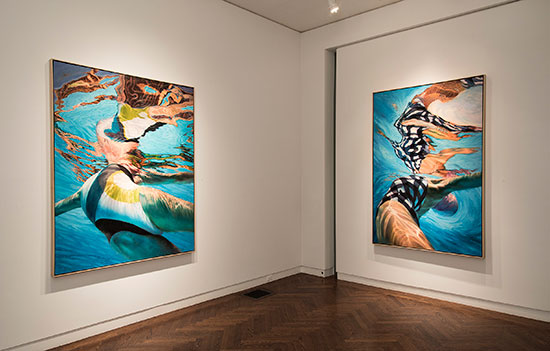
“Lorraine Shemesh: Inside Out” at Gerald Peters Gallery.
.
That stage-by-stage metamorphosis, which Ovid so brilliantly captured in the climactic moment of each episode in his masterpiece, is caught in Shemesh’s Lunge, which suspends the discernible figure of the boy just at the moment his head breaks the surface of the water. The viewer can almost hear the adults poolside breathe a sigh of relief they will not have to rescue him.
Shemesh is well known in New York art circles, having had eight solo shows at the Allan Stone gallery from 1981 to 2011 (this is her first with Gerald Peters). Her paintings are included in the collections of the Butler Institute of American Art in Youngstown, Ohio, the Boise Art Museum, the DeCordova Museum in Lincoln, Massachusetts, and the Rhode Island School of Design Museum. Her secure hand in painting the figure was trained at the Tyler School of Art and Boston University, while the colors hint at a strong familiarity with the Bay Area painters, including Richard Diebenkorn and Wayne Thiebaud. She lives and works in New York City.
.

“Lorraine Shemesh: Inside Out” at Gerald Peters Gallery.
.
There is a secret subtext to the show. The exhibition combines the seven large oil paintings with studies (many of them graphite wash on mylar, a notably liquid medium). Most important but easily missed, there is also a group of ceramic vessels, decorously arranged on shelves near the door, that Shemesh made in between painting sessions using a Japanese process called Neriage (colored clays layered to build patterns in vessels). Many of the vessels also abide by the doubling (above and below the water line, tight and loose, realistic and abstract) that make the paintings so admirably dialectical.
.
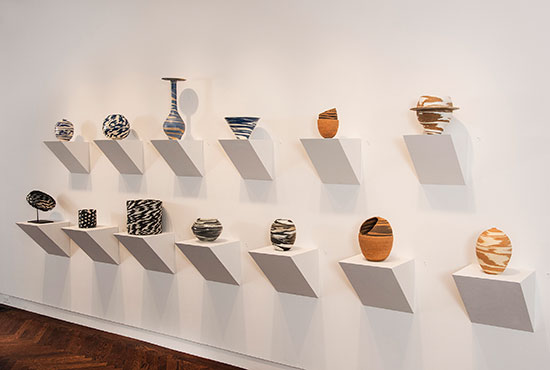
Ceramics by Lorraine Shemesh on view in “Lorraine Shemesh: Inside Out” at Gerald Peters Gallery.
.
Among them, the Blue and White Twist Vessel, made last year, is a pointed reminder to note the correspondence not only with the fluid idiom of the paintings, but the floating divers of the Matisse cutouts that are trawling the art historical background of the show. As she says, “Clay has a memory, is easily broken, sensitive to touch and temperature, capable of fragility and strength, and greatly affected by the atmosphere in which it finds itself.”
.
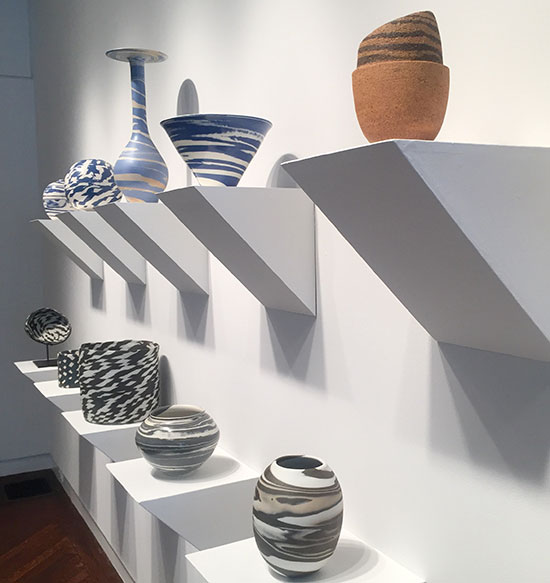
Ceramics by Lorraine Shemesh on view in “Lorraine Shemesh: Inside Out” at Gerald Peters Gallery.
.
I would recommend a sea poem as the perfect literary accompaniment to this show. It is not by John Masefield or Walt Whitman, celebrants of the ocean in its epic aspect; its author is the more lyrical Wallace Stevens, who fled Hartford and his dreary job in insurance for the inspiration of the waves at Key West. It was in Florida that he composed an ode worthy of Keats on the metamorphoses of form that Shemesh so avidly records.
In “Idea of Order at Key West,” Stevens also captured the way sound is changed by the wind and waves, mingling seascape and figure, one becoming human and the other inhuman. It opens:
“She sang beyond the genius of the sea.
The water never formed to mind or voice,
Like a body wholly body, fluttering
Its empty sleeves; and yet its mimic motion
Made constant cry, caused constantly a cry,
That was not ours although we understood,
Inhuman, of the veritable ocean.”
__________________________________
BASIC FACTS: “Lorraine Shemesh: Inside Out” is on view May 7 to June 10, 2016 at the Gerald Peters Gallery, 24 East 78th Street, New York 10075. www.gpcontemporary.com.
__________________________________
Copyright 2016 Hamptons Art Hub LLC. All rights reserved.
